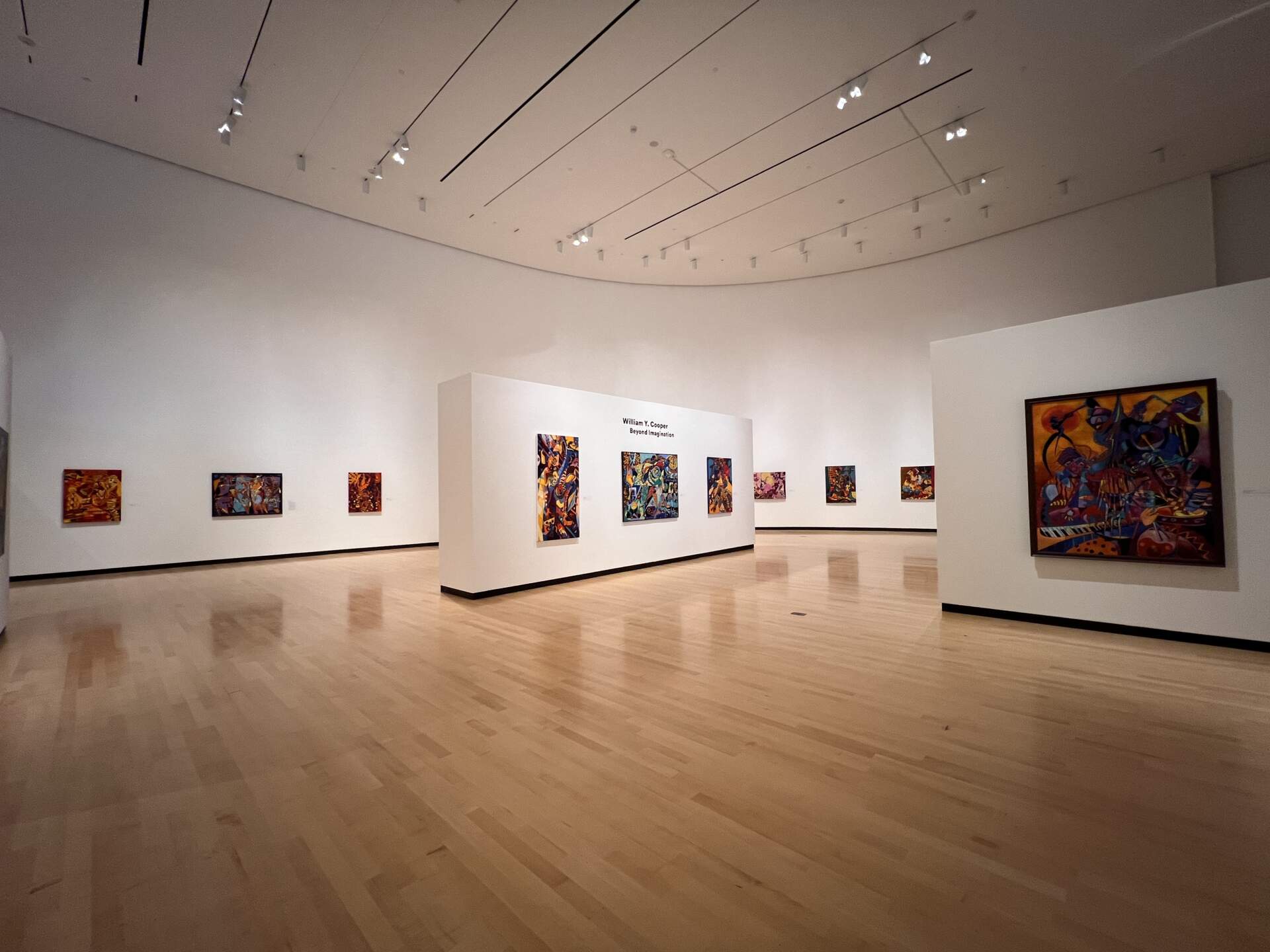
William Y. Cooper (1934-2016), Naming Ceremony, Ghana, 1994; oil on canvas, 48 x 60 inches; Burchfield Penney Art Center, Purchase, 2011
William Y. Cooper: Beyond Imagination
Past
Jul 12, 2024 - Oct 27, 2024
William Y. Cooper’s legacy as a painter, printmaker, muralist, and educator has left an indelible mark on Buffalo’s art community. His compositions are distinguishable for their bustling rhythm and for Cooper’s luminous use of color and line to compose a melody of stories and moods. A self-proclaimed Afrocentric artist, he fuses his African heritage with his American experience. Beyond Imagination celebrates the breadth of Cooper’s work and the embodiment of his art as the “noblest expression of the human experience.”
Considering the vibrant and intricate nature of his paintings, it’s hard to believe that Cooper was once afraid of color. He recalled during a 2013 Burchfield Penney Living Legacy interview that he feared layering more than one or two colors in a single piece. Earlier works like Portrait of Sharon Holley show such restraint in both color and subject matter, which were primarily portraits and realistic figurative studies. Miles focuses similarly on a single subject but shows his progression working with color.
As Cooper’s style evolved, his African heritage also became more visually apparent. He incorporates West African Adinkra symbols, representing different African proverbs, throughout several paintings. Repetitions of colorful patterns illustrate figures with elongated features and faces reminiscent of masks, highlighting the influence of African aesthetics. These are often juxtaposed with references to Christian biblical stories, fusing African and American spiritualism.
This development coincided with a broader movement of Black artists reconnecting with their African heritage and expanding expressions of blackness beyond figurative representation. Artists in the Chicago-based collective AfriCOBRA, for instance, established an Afrocentric style composed of vibrant “Kool-Aid” colors that mixed abstraction and representation, creating rhythmic works rich with meaning and cultural influence.
Leaning into geometric abstraction and cubism, Cooper embraced a similar aesthetic. His later works transcended from visualizing the literal to the metaphorical. Naming Ceremony, Ghana portrays his transformative experience visiting Ghana and receiving his African name in a special ceremony. A slew of blues, red, yellow, and green creates an otherworldly scene that requires an extended look to see the narrative embedded within.
Heavily inspired by music, Cooper rarely painted without it. The fragmented and interpolated rhythms of jazz echo in how he deconstructs conventional narrative to convey a complexity of feeling. Jazz Festival is one grand example of jazz’s prominence in Cooper’s world, depicting a lively band with percussion, drums, bass, and piano composed of abstract forms and colors. Jazz Giants builds on this as a similar scene is grounded by the faces of some of the genre’s icons.
Layers of colors, faces, stories, and forms nod to the symbolic nature of his paintings, which challenge viewers to slowly observe the many details of each piece. Creative and curious by nature, Cooper embraced ambiguity. He wanted viewers to connect with his paintings to develop their own interpretations, pushing the bounds of their imagination in the process.
His work celebrates the nuance of blackness while recognizing the triumphs and tragedies of Black American life. 4 Little Girls responds to the heinous 1963 16th Street Baptist Church bombing that killed four girls attending Sunday school in Birmingham, Alabama, Cooper’s hometown. Waiting in New Orleans is another socially driven meditation on the devastation of Hurricane Katrina. Both paintings employ dark blues to evoke a somber, heavy, and mournful mood.
While these and other works are an unflinching reflection on some of the darker realities of Black American experiences, Cooper also celebrates blackness. He had a strong admiration for Black women, growing up surrounded by nurturing, loving, and caring women. He honors the dynamic beauty, resilience, sensuality, and softness of everyday women and historical figures like Sojourner Truth and Rosa Parks, simultaneously asserting their power and vulnerability.
A beloved muralist, Buffalo Arts Studio artist, and educator, he brought the concepts of his practice to the public in numerous murals throughout Buffalo. His studio was a popular community space where he inspired generations of artists, fostering conversation around the interconnections between art and life. Cooper’s desire to find answers to questions big and small sparked a curiosity that freed his creativity and carried into his paintings. This spirit lives on in his work, inspiring us to discover connections between our past and present that unlock the power of our imaginations in the process.
William Y. Cooper: Beyond Imagination is presented through the support of our Burchfield Penney members. We are thankful to Glendora Johnson-Cooper and all of the individual collectors for generously sharing this work with the community.